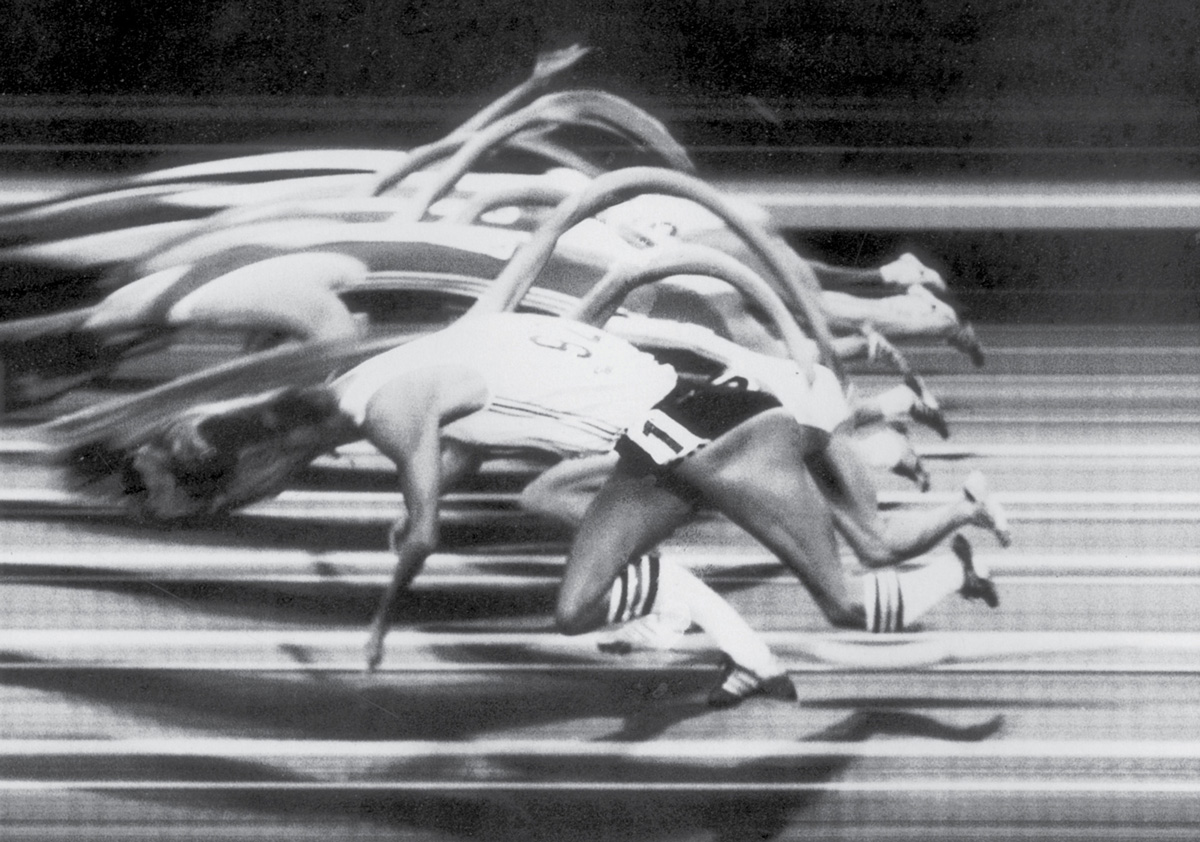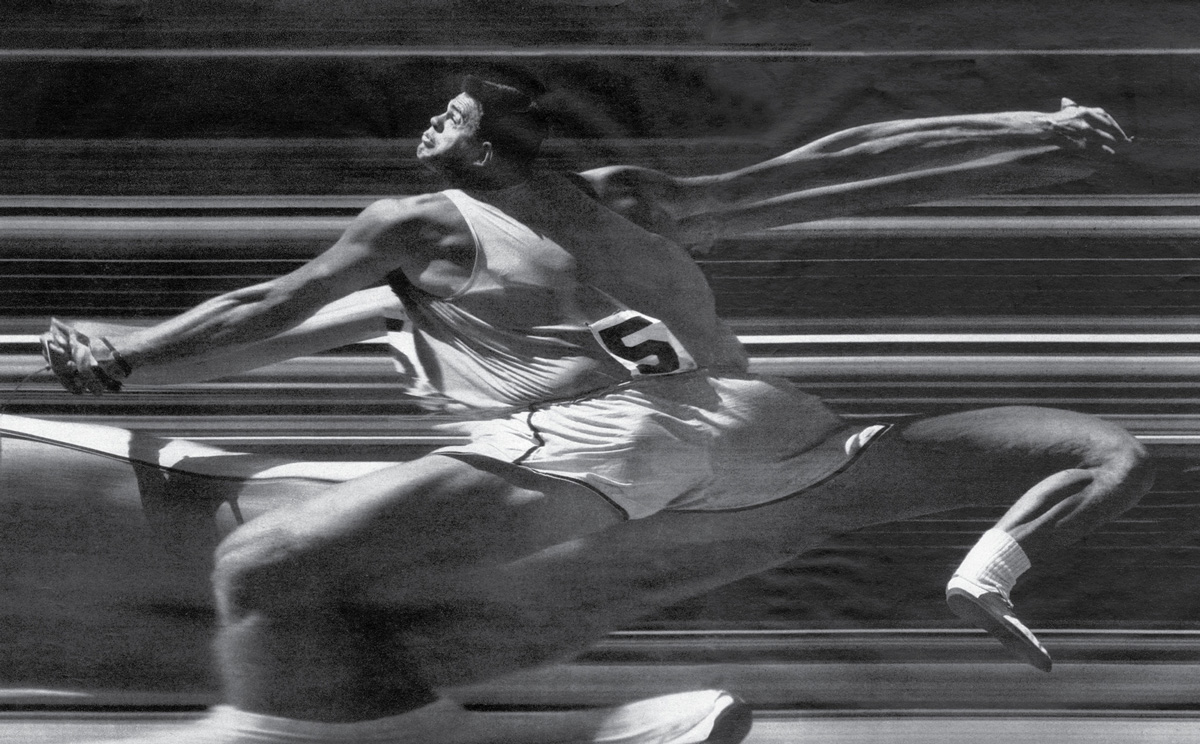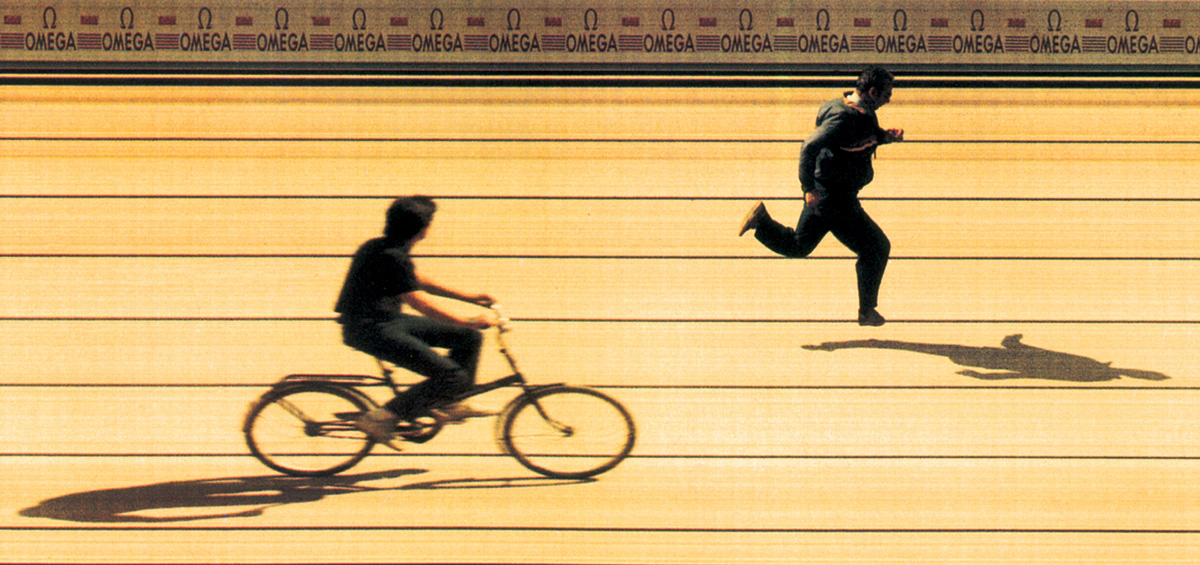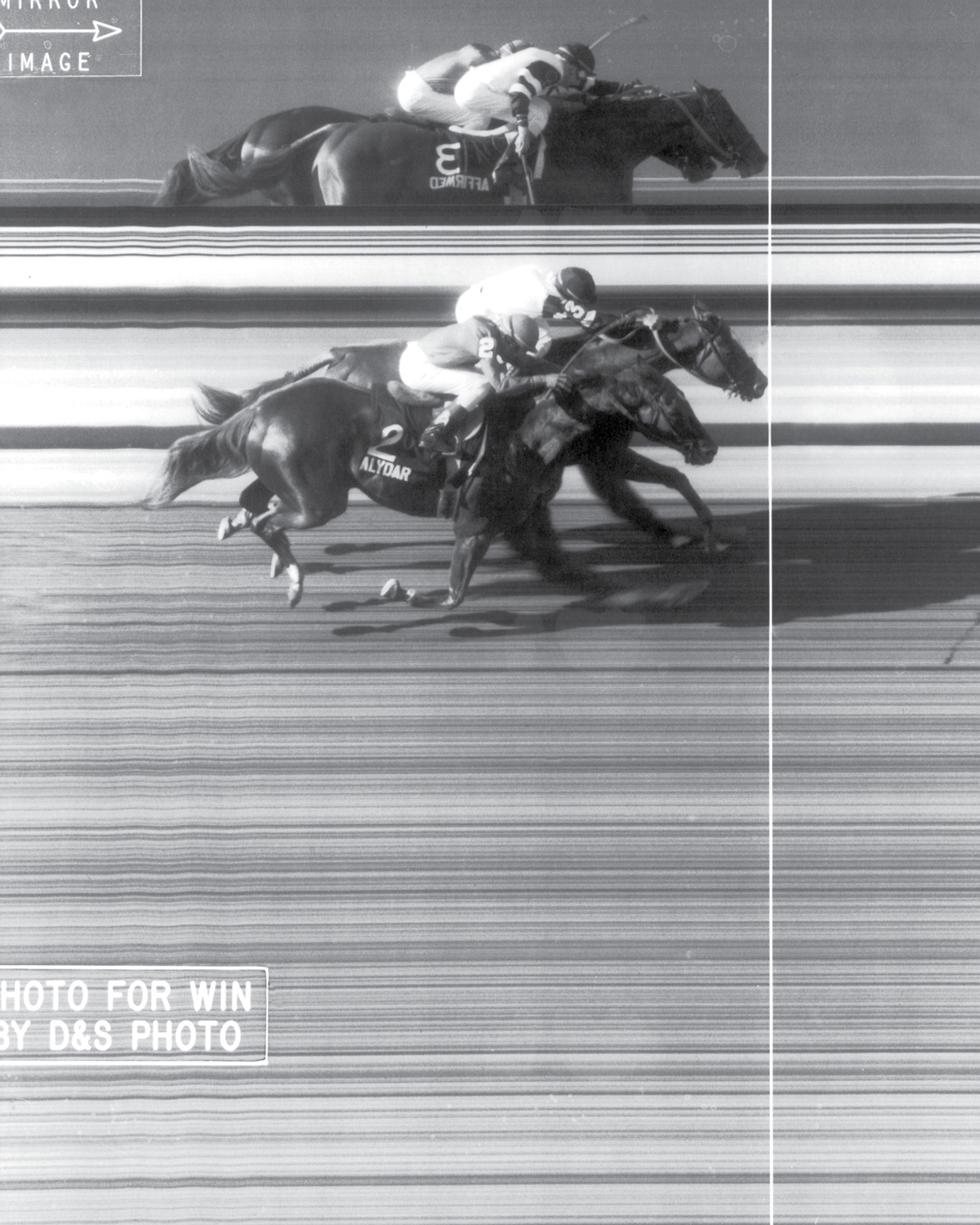A Wrinkle in Time
The distorted precision of photo-finish photography
Kris Belden-Adams

A photo-finish image is the only surefire way to determine the results of a race—and the fate of millions of dollars each afternoon. Just ask Don Morehouse, who has been taking photographs of horse-race finishes for more than thirty-five years for the New York State Racing and Wagering Board. “The photo finish has stood the test of time over the years,” he says. “You can’t get any truer than that. I’ve had guys ask me to fix race results. I tell them to come up and watch me photograph a race so they’ll see for themselves that there’s absolutely no way you can cheat this system.”
Reliable as they may be, photo-finish images are also blatantly untruthful. They’re full of distortions: horses’ legs may disappear; rowing oars often look as if they are made of rubber, and the crews that ply them seem out of synchronicity; chariot wheels look oval-shaped. What we see is illogical. How can a chariot with an oval-shaped wheel move at all—let alone at the rate of fifty-five feet per second? Given these distortions of reality, why then are photo-finish images held by the horse and dog racing industries, the Tour de France, and the Olympic Games to be more trustworthy than the human eye at determining race placings? How do we reconcile their abstract nature with the fact that these images are deemed so reliable that they are legally binding in a court of law as the only fail-safe method to determine the fate of gold medals and millions of dollars? How can we have it both ways?
Closer examination of the making of a photo-finish image reveals that it can be both true and false at the same time. A photo-finish image depicts a fixed, vertical strip of space (the finish line) over time, using a moving strip of film that travels inside of a shutter-free camera at the estimated speed of the racing objects. In a photo finish, we see only objects that were moving as they passed a four-inch-thick vertical strip of space at the finish line. The usual expectation that a photograph will reveal spatial relations at a given instant of time is reversed. Instead, the photo-finish image depicts a fixed location—the finish line—over elapsed time.
This is contrary to the way we are accustomed to experiencing the passage of time in most photographs. According to Dr. Andrew Davidhazy of the Rochester Institute of Technology, viewers have come to expect that a photograph has only one relationship to time and reality. “We are programmed to think about photographs as representing instants in time,” he says. “And therefore we have a horrible time relating to images that portray time itself as one of the dimensions of the final image. ... Most people don’t think of time as the fourth dimension. It just is.”
Technically called “strip photography,” the photo-finish process—using a camera invented by Lorenzo del Riccio of Paramount Studios—was unveiled in 1937 at Bing Crosby’s Del Mar Turf Club, the horse track of Hollywood’s rich and famous. The basic technology has changed very little in the seven decades since its invention. A photo-finish image is made by a camera with an extremely thin, vertical slit. It is positioned in a booth in the grandstands above the finish line, and the camera is focused on a four-inch-thick slice of space at the line. A switch is flipped by a photographic technician just before the race participants reach the finish line. Film begins moving past the slit and is exposed. Racing horses run past the four-inch exposure space at (hopefully) the pre-calibrated speed of the film’s movement. Only moving things are recorded on film; anything static appears as a streak. Thus, an image of movement past the fixed point over time is recorded. This phenomenon is similar to the way reality might appear when viewed through the slat of a fence: if something is moving on the other side of the fence, it can be seen by standing still and watching the complete object as it passes.
The photo finish was quickly adopted by the nation’s premier racetracks nationwide, and proved to be a surefire moneymaker. Despite the fact that the Great Depression caused tracks to lose revenue, many chose to cut back on landscaping in order to fork over a staggering $300,000 (the equivalent of $4 million today) for the first photo-finish cameras. This decision paid off, because purses more than doubled where cameras were installed. For instance, at Santa Anita in California, the “handle,” or the total of all the bets, on the day before the camera was installed was $221,537 ($3 million today). The following day it was $536,000 (today’s equivalent of $7 million). In just a few days’ time, the cameras had paid for themselves.
According to sportswriter Robert Harron of Collier’s Illustrated Weekly, “this electric camera has reduced horse-race finishes to a scientific certainty, doing away with the error of oblique viewing and all other pitfalls.” He continued his praise of the new technology: “The announcement [of the race finish] was greeted with cheers, the purse was split, the jockey fees were split and the customers were satisfied. Horse racing is one business-sports enterprise in which the customer can’t always be right. If he were, somebody would go broke a great deal faster than you and I do now. But if we have to lose our money—and it was Damon Runyon who observed laconically that ‘all horse players must die broke’—I think it is only right that we lose it in the most painless manner possible. …The Eye in the Sky has eased the pain in the vicinity of the pocket in which you carry your wallet, for you must admit that the shock of losing isn’t nearly so painful when it is quick and beyond all doubt.”[1]
Despite such admiration for photo-finish systems—a popularity no doubt abetted by the general public’s fascination with futuristic technologies like X-rays, motion pictures, and the instantaneous wire transmission of news photographs—the “scientific certainty” provided by a photo finish is anything but truthful. If the film is calibrated to move faster or slower than the subjects, parts of the image will be distorted. This occurs very often in photo-finish images. Slower objects are elongated. Quicker objects appear compressed. This is why wheels moving faster than the racing figures appear oval-shaped. Another common distortion in photo-finish images is the appearance of a “ghost leg”: if a horse happens to step on the finish line as it passes by, for example, its leg will be still and will thus appear as a ghostly blur.

The photo finish is also used to document race finishes in the sports of cycling, canoeing, motor-boating, speed-skating, roller-skating, dog-racing, and rowing, as well as in track events. The most pronounced distortions occur in photos of those activities that involve numerous moving parts or limbs. Rowing crews, for instance, frequently look odd in photo-finish images. We know that championship crews row in perfect synchronicity, and with rigid, functional oars, but because the crew and oars are in the midst of different parts of a stroke as the boat passes the camera’s exposure slit at the finish line, “bendy oars” can often appear in the image, with the crew itself appearing to be weirdly out of cadence. This distortion occurs because the photo finish reveals a static image of a state of becoming, one that ended with the achievement of the moment we see—the crossing of the finish line. Because time itself is distended in photo finishes, these images constitute a unique rupture in the instantaneous representation of time that we have come to expect from photographs.
This rupture can make some viewers very uncomfortable. For example, on 28 August 2004, the Toronto Star’s editors felt compelled to provide their readers with a lengthy apology for running a photo-finish image of a rowing match from the 2004 Olympic Games that they later felt was deceptive:
It wasn’t a photo as most of us know photos. Just an image of four British rowers nosing out four Canadians at the finish line—a picture of time created through the miracle of Scan’O’Vision. … But if you look closely, the image isn’t real. … Oars no longer are synchronized. And the winning boat seems longer. That’s because the composite image only shows you how various boat and rower parts appeared as each crossed the finish line. Goodness, this is complicated. But here’s the point. The Star published an artificial Scan’O’Vision image but told readers it was a photo. That’s a no-no. The Star’s policy manual … warns editors not to use manipulated images, composites, graphics and montages.
As the Toronto Star’s editors suggest, photo finishes—which are expected to behave as “conventional” instantaneous photographs—require viewers to imagine a new relationship between photography and time, and between truth and abstraction. But how, then, is a photo finish truthful at all, if the image we see fails to conform to the reality we can verify with our own eyes?
Photo-finish images, for all of their wild distortions, do represent the intervals between objects and the moments when they passed the finish line with absolute fidelity. No matter how elongated or compressed an object might appear, the relative intervals between it and other objects will be recorded with precision within 1/2,000th of a second. Despite the distortion caused by the speed of a racing object, nothing appears on the film until the precise moment when an object moves past the finish line. No amount of distortion can make an object reach the finish line (and be exposed on the film) any sooner.

Strip-camera technology also can be used to experiment with photography’s relationship to time and space. If moving objects are photographed by a photo-finish camera while they are moving in opposite directions, the camera will record them as if they were moving in the same direction—the direction of the film’s movement. And strangely, the subjects’ shadows will still appear to be cast in the same orientation, relative to the objects, as they were in reality. A similarly puzzling effect occurs when a strip photograph is taken from the window of a moving car in which the camera is calibrated to move the film at the precise speed of that car; in such a case, the widths of parked cars will appear to be normal, while those of passing cars will appear compressed.
These examples of non-racetrack uses for strip photography speak to the degree to which the making of a strip photograph is implied in the image itself. You cannot really understand what you see unless you imagine exactly how it was made—and grasp the degree to which that process is a departure from photography’s norm. However, what makes the photo finish so interesting is that it almost can pass as a “normal” photographic image—which is to say, one that has a standard relationship to time and space.
In photo-finish photographs, we see a phenomenon described by Roland Barthes: that of a photograph’s power of authentification exceeding its power of representation.[2] In other words, a photograph can be absolutely truthful when it comes to recording the order of the racers as they cross the finish line, while failing to depict the racers themselves as they really appeared. A photo finish is regarded as fail-safe, and as absolutely accurate to one kind of reality—but not to another. In a photo finish, we have it both ways. The image is both true and false, simultaneously. A photo finish is an example of what Charles Sanders Peirce had in mind when he defined his own notion of the “index” as a form of representation that results from direct contact with an object. (For example, a footprint in the sand may function as an index of both the foot that made it, and of the act of a foot pressing into the earth.) Peirce’s definition of the index allowed representations to have a fluid relationship to their corresponding objects, and to reality.[3]
The ability of photography to confound our sense of perceptual logic by mixing “truthful” indexicality with abstraction has always been part of its aesthetic appeal—an appeal that was perhaps best understood by its pioneers. One of photography’s founding fathers, William Henry Fox Talbot, forthrightly incorporated photography’s indexical slippages in Plate XX, “Lace,” from The Pencil of Nature, as early as 1844.[4] The intricate weaving of this lace appears so naturalistic and so real. But as Talbot himself tells us in The Pencil of Nature, his only objective was “to exhibit the pattern with accuracy.” The lace, which appears white in the image, was in fact black. Talbot’s experiment illustrated that “photographic truth” can be conditional. Similarly, it might not be that difficult to understand how a photo finish can simultaneously be faithfully indexical to the order of race placings, yet not provide a true representation of the racers’ physical appearances.
Incidentally, the very beginning of high-speed photography can be attributed to Talbot’s experiments.[5] In 1851, he attached a page of the Times of London to a wheel, which was rotated in front of his camera in a darkened room. As the wheel turned, Talbot exposed the page to light for 1/2,000th of a second, using spark illumination from Leyden jars. This experiment resulted in a readable image, and the birth of photography’s capacity for instantaneity.
Eadweard Muybridge also played a role in the invention of the photo finish. In 1872, when California Governor Leland Stanford got into an argument with James W. Keene over whether the four feet of a horse are ever all off the ground while it is galloping, the governor commissioned Muybridge, who worked as a surveyor for the government, to take photographs of a galloping horse to settle the debate. His first attempts to photograph a horse using a single, high-speed exposure proved futile, but he eventually succeeded with a system that used multiple, single-exposure cameras whose shutters were tripped by threads. In May of 1872, Muybridge began his first attempts to photograph a horse called Occident at the Union Park Race Track in Sacramento using twelve cameras and an electromagnetic shutter-release system, eventually producing visual evidence that a horse does indeed have all of its feet off the ground at certain points of its gallop. Muybridge was also the first to suggest that a camera be used to determine the winner of a horse race. In a letter published in Nature magazine in May 1882, Muybridge suggested that in the future no important race should take place without a photo of the finish to determine the winner.[6]

Although photo-finish images give us many reasons to doubt their truthfulness by deforming and contorting their subjects and by stretching our conceptions of how a photograph relates to time, those things matter very little when the purpose of the image is to determine the order of a race finish with an accuracy that far surpasses that of our own eyesight. Studies have determined that the human eye can accurately register no more than four images in a second, compared with the photo finish’s recording speed of 1/2,000th of a second. As swimmer Nancy Hogshead, who won the gold medal in the 100-meter freestyle at the 1984 Los Angeles Olympic Games, observes, “When you win a gold medal by a hundredth of a second, you’re happy you didn’t leave it to error.”[7]
- Robert Harron, “Eye in the Sky,” Collier’s Illustrated Weekly, 19 September 1936, p. 60. Harron was commenting on single-exposure photo-finish technology, which preceded strip camera technology. Single-exposure photo-finish images were made by a camera that was positioned at the finish line. The camera’s shutter—which captured 136 images each second—was triggered as a horse broke a thin thread on the race track. All too often, the single-exposure photo-finish camera failed to capture the decisive, first-place finish-line moment. These cameras only were used for first-place finishes, and provided no help in determining any of the other race placings. The oldest single-exposure race-track photo-finish images discovered so far were made by J. C. Hemment in 1890. See Gail Buckland, First Photographs: People, Places and Phenomena as Captured for the First Time by the Camera (New York: MacMillan Publishing Co., 1980), p. 126.
- Roland Barthes, Camera Lucida (New York: Hill and Wang, 1981), p. 89.
- Charles Sanders Peirce, “Logic as Semiotic: The Theory of Signs,” in Robert E. Innis, ed., Semiotics: An Introductory Anthology (Bloomington: Indiana University Press, 1985).
- William Henry Fox Talbot, The Pencil of Nature (New York: Da Capo Press, 1969), Plate XX.
- Gail Buckland, Fox Talbot and the Invention of Photography (London: Scholar Press, 1980), pp. 107–118, 202.
- Jean-Pierre Bovay, Le Sens du Temps: Photografie et Perspective de Temps (Bienne, Switzerland: Omega, 1988), p. 12.
- Robert Ebisch. “It’s All in the Timing,” Sky Magazine (December 1995).
Kris Belden-Adams is a doctoral candidate in art history at the City University of New York’s Graduate Center. She is writing a dissertation on photography’s unique and complicated relationship to time and indexicality.